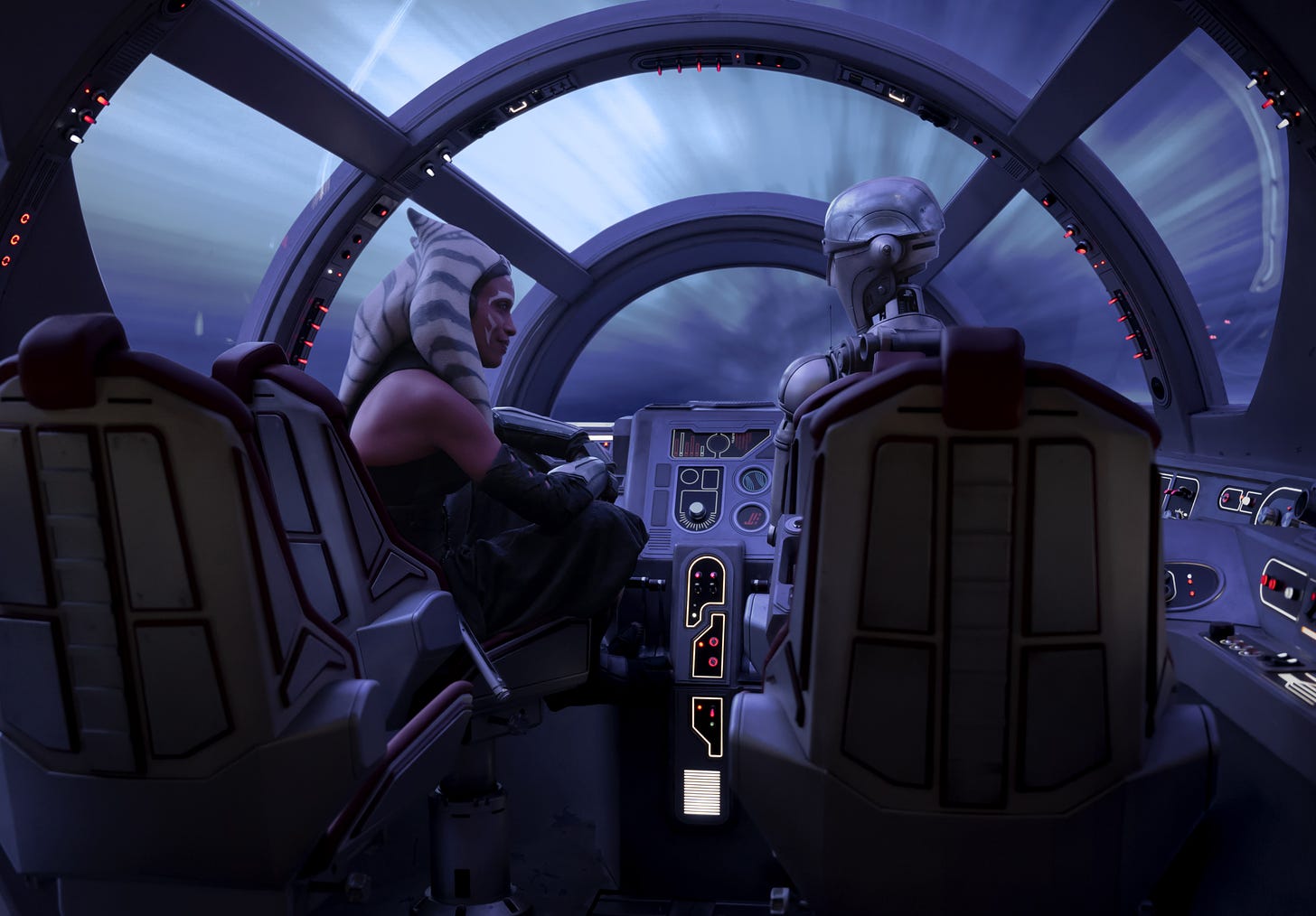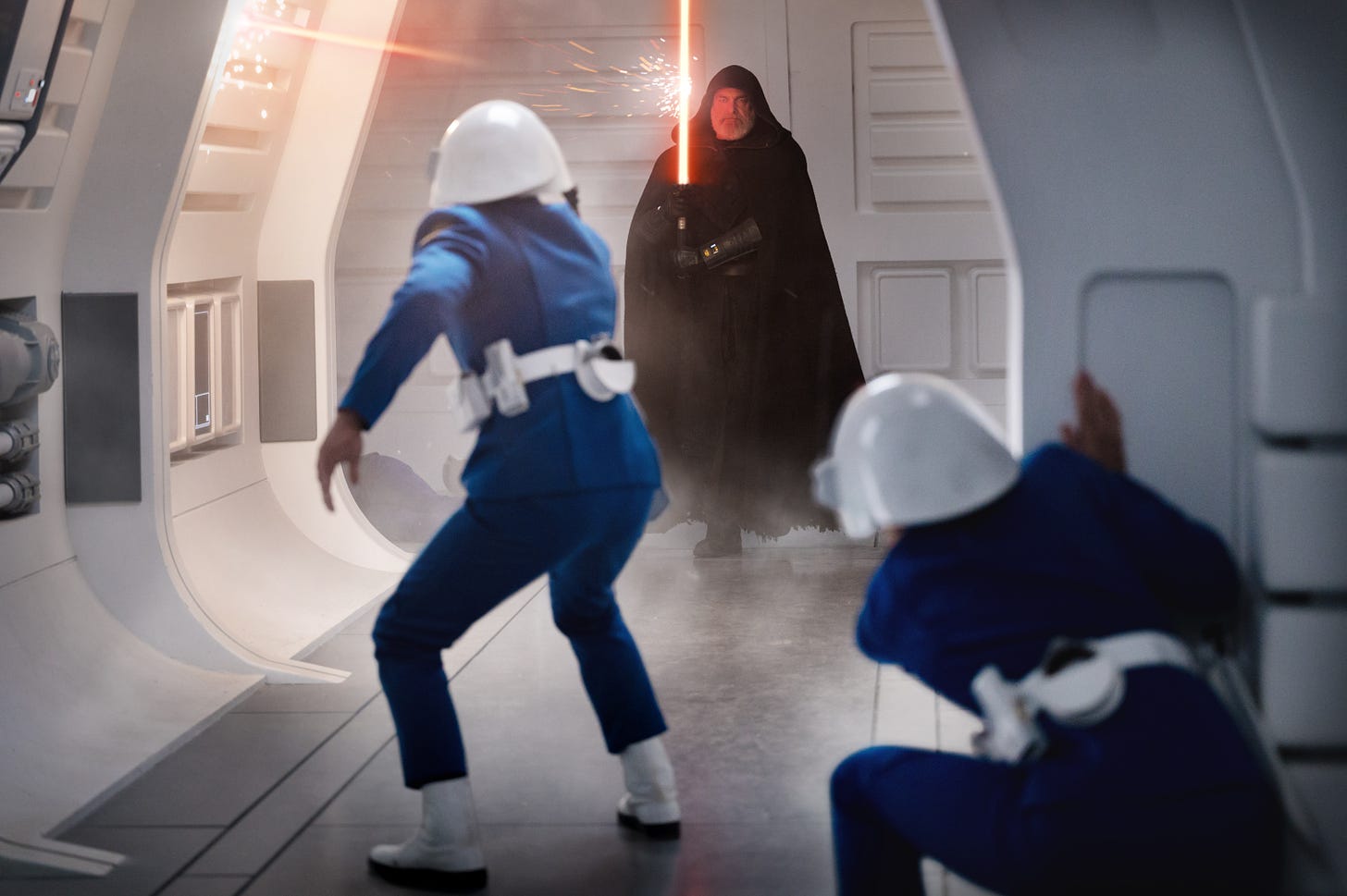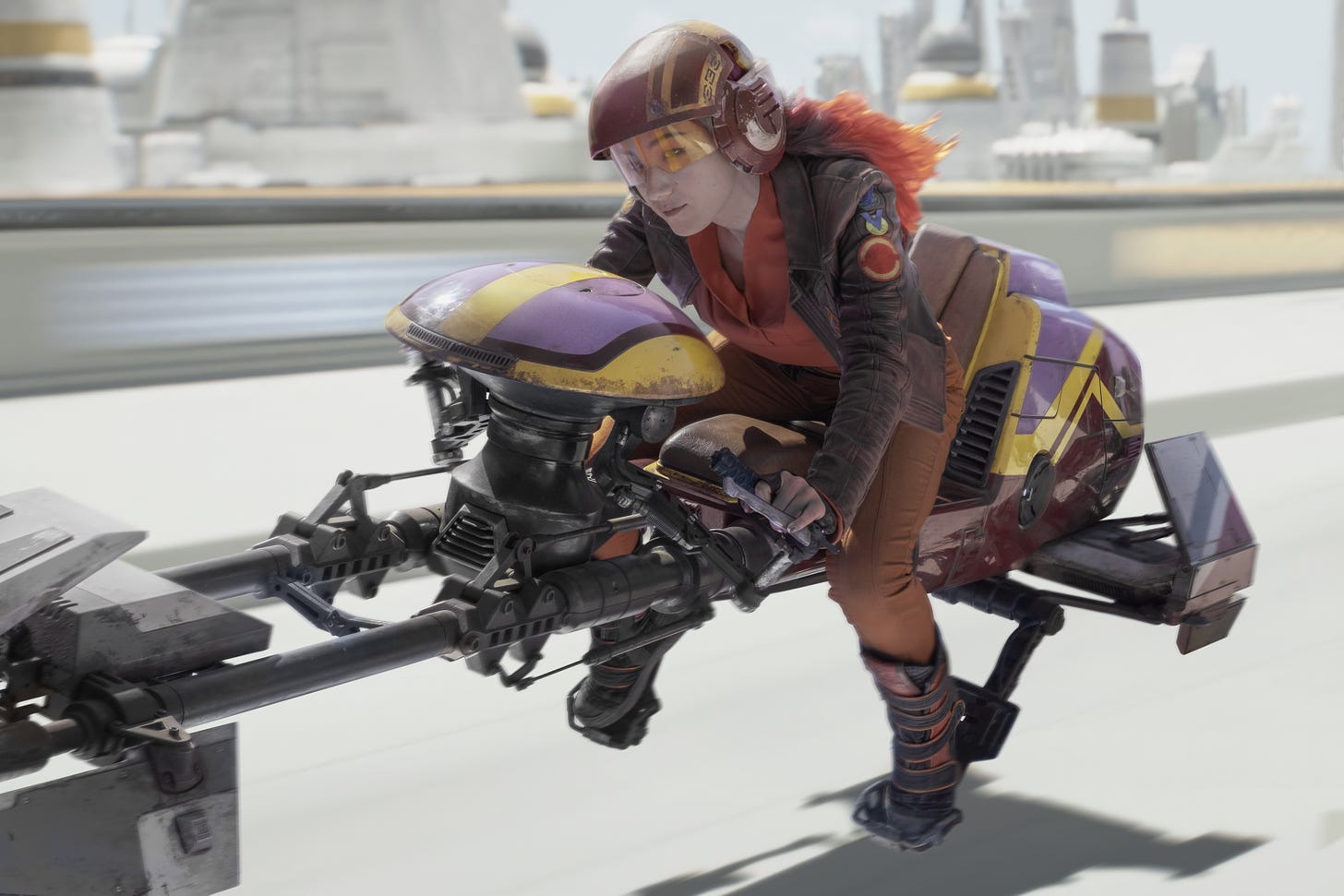Review: Ahsoka, "Part One: Master and Apprentice" & "Part Two: Toil and Trouble" | Season 1, Episodes 1 & 2
Traveling once again to a galaxy far, far away
Welcome to Episodic Medium’s coverage of Ahsoka, the latest installment in Disney+’s expansion of the Star Wars universe. As always, this review is free for all, with subsequent reviews exclusively for paid subscribers. We’ll have more about our full fall lineup (and a deal on yearly subscriptions) next week, but check out our About Page in the meantime for more information.
“The past is the past. Move forward.”
There’s not a great deal in the two-episode premiere of Ahsoka that’s funny, intentionally or otherwise, but the line quoted above did make me snicker. If there is anything true of the vast Star Wars franchise, it is that the past weighs heavy on its characters, and moving forward is extraordinarily difficult, if not flat-out impossible. Within the stories told on the small or large screen, the past is what drives characters from Anakin Skywalker to Mando, and everyone in between. From the vantage point of the casual viewer, the only thing moving forward in this franchise are special effects, because every story being told on TV or in film is either the broad-strokes version of the Skywalker Saga, or filling in the gaps between those broad strokes.
I will mention here—to anyone who did not read my reviews of the most recent season of The Mandalorian or the first season of Andor at this fine publication—that I am a casual Star Wars fan.1 I am telling you this because I know this is a safe space. I know that new or existing subscribers to this Substack will not judge me harshly for being a casual viewer of the Star Wars series. I know that you will not be mad when I reveal that being a casual viewer means that I have never seen an episode of Star Wars Rebels. If the concept of casual fandom was not clear before, let that be the line in the sand. I’ve seen all of the Skywalker Saga films. I’ve even seen the Star Wars Holiday Special, the 80s-era Ewok movies, and the 2008 animated film Star Wars: The Clone Wars.2
I have not watched the various animated series set in the world of Star Wars, though. It is not automatically true that Star Wars Rebels is required viewing for Ahsoka, but it sure seems like that would be helpful. On one hand, the plot machinations detailed in these two episodes are easy enough to grok if you have at least watched the four seasons of The Mandalorian. (I know, I know, technically The Book of Boba Fett is a separate show, but…c’mon, it’s a stealth third season of the Adventures of Mando and Baby Yoda.) Ahsoka Tano is reunited with her old friends Hera Syndulla and Sabine Wren so they can find and use a star map to point them towards two supposedly dead people: their other old friend Ezra Bridger and the evil Grand Admiral Thrawn. Their quest is as much to find Ezra and stop Thrawn as it is to stop Thrawn’s acolytes from catching him first.
While the plot of Ahsoka is simple enough so far, the viewing experience is still moderately baffling if you, like me, don’t have any connection to or awareness of Hera or Sabine or Thrawn. Courtesy of the most recent season of The Mandalorian, I am already clued into a few key aspects of this series, from having encountered the live-action version of Ahsoka and her quarry Morgan Elsbeth, as well as the fact that Grand Admiral Thrawn is—or was—a Very Bad Dude. I could spend plenty of time wondering why it is that such a Very Bad Dude was never mentioned in the Skywalker Saga series of films themselves (at least the most recent trilogy, since he did not exist within the Expanded Universe until the 1990s, as I learn from a Google search). But I get it: he’s bad, and if he was brought back, it would be bad.
But that’s the setup of Ahsoka, so it’s not really a question of “if”; Thrawn will come back at least in this series. Setup is the key of both “Master and Apprentice” and “Toil and Trouble”, to the point where I’m surprised it’s not all just one long episode. (Disney+ is wisely releasing both episodes together.) The first episode ends with an immensely pointless cliffhanger, within the context of this specific story, the context of Star Wars, and the entirety of genre filmmaking these days. You can tell me in the comments exactly how mad you would be if Sabine Wren really had been killed off at the end of “Master and Apprentice,” courtesy of a lightsaber to the gut from the intense-looking Shin Hati (Ivanna Sakhno), who serves her ex-Jedi master Baylan Skoll (the late Ray Stevenson). What I can say is that I was the opposite of surprised to learn, in the opening scene of “Toil and Trouble,” that she was recovering from a lightsaber in the gut. Will wonders never cease, etc.
It’s the placement of that cliffhanger in the larger context of Ahsoka, and Star Wars in general, that stands out. The premise of this show hinges on the idea that both a bad guy and a good guy who everyone has thought died are still alive. Those of you who saw Rebels will know better than me how realistic it is for Thrawn and Ezra to have survived…whatever they supposedly died from. But I’m guessing the journey will be reviving for both of them, if not Thrawn. So the idea that anyone in this show is set to die seems pretty ridiculous. There is no such thing as death in a big-budget franchise like Star Wars. There is only the delay of death, in favor of appearing in other shows or films or simply being brought back to life with the magic of CGI.
The former of those options is the case throughout both opening episodes of Ahsoka; I was not super-surprised to confirm that many of the returning characters here are played anew by more recognizable actors, replacing the voice performers from Rebels. Rosario Dawson, of course, is well known from many different films as well as from her appearances in Mandalorian and Boba Fett. I’m curious how fans will react to Mary Elizabeth Winstead as Hera or Natasha Liu Bordizzo as Sabine, both of whom are also stepping in for voice performers. I enjoyed Winstead’s easy chemistry with Dawson. I was less enamored with Bordizzo’s work, though Dave Filoni (who wrote both episodes) doesn’t give her much material with which to work, aside from painting with a very broad brush to make sure we all know that Sabine is Edgy and Daring and Risky.
See? Look at that picture. She’s riding a speeder real fast! She’s ignoring orders to attend a statue dedication! Edgy! The flip side of her characterization is the apparently genuine shock with which Ahsoka registers Sabine having taken the star map “even though I explicitly told her not to” after their first reunion. Why, I never! The tone of that line reading—even though Dawson’s appeared in plenty of comedies, I did not take it to be anything less than serious and straightforward—is similarly met by the core struggle in “Toil and Trouble.” There, as Sabine recovers and wrestles with her survivor’s guilt, Hera and Ahsoka travel to Corellia to see if Morgan’s old Imperial shipyard is still operating with double-dealing on the ledger. There, they meet the new businessman (Peter Jacobson) in charge of the Corellian plant, who learns the hard way that the former Empire-held plant is still overrun with people loyal to the Empire.
I’m still not entirely sure how intentional it is that shows such as Andor and this are spotlighting how frankly stupid the presumed good guys are. There can be plenty of talk of the banality of evil as it’s depicted, especially in the slow-burn drama Andor, but there must also be consideration made for the danger of good intentions. The Corellian businessman waves away the idea that the ex-Empire employees who make the plant operational may still be loyal to the baddies, and is quickly disabused of that notion. But the very concept of this show—that a very bad person who everyone assumed was dead is not dead, in part because no one verified that assumption—has it baked in that the various iterations of evil in this saga keep springing up because no one does the hard if tedious work of verifying that evil has been vanquished.
Perhaps if it wasn’t for other characters being revived in other shows or films, such as Emperor Palpatine having…uh…somehow returned, this would be less vexing. If you know Rebels, you may feel confident that Ezra and Thrawn still being alive makes perfect creative sense. What I know is that this show hinges on them being alive because no one thought to check and see if they were dead, which is arguably very dumb. If there was more to Ahsoka to start with, it would be easier to get hooked. A shrewd person could point out that I was pretty hesitant about the opening stretch of Andor last year. But Andor had the benefit of being overseen by Tony Gilroy, who isn’t remotely as beholden to the Star Wars franchise as more than a means to an end of exploring the aforementioned banality of evil. Having watched The Mandalorian and The Book of Boba Fett, overseen in some capacity by Filoni (who also directed the first of today’s two installments), I am less convinced that he’s got tricks up his sleeve.
Both Andor and Ahsoka have the danger of running up against the same problem, though the former was more surprising in its first-season arc. Andor has to, by its very nature, lead up to the events of Rogue One, and thus to the events of the first Star Wars trilogy. Ahsoka, meanwhile, can only do so much because of being placed chronologically before The Force Awakens and the rest of the Rey Skywalker (ugh) trilogy. So while Ahsoka and Hera are unearthing some Imperial remnants, we know those remnants will comprise the First Order over time. The peace is uneasy, and we know it’s going to end right quick. Andor wound up feeling a lot fresher in spite of its limited scope. Ahsoka has a similarly limited scope so far. But the two-part opener gives me admittedly limited hope for its future.
Stray Observations
The downside to long-in-advance casting announcements is that you turn into Milhouse Van Houten and ask, “When are we getting to the fireworks factory?” I get why Disney announced that Hayden Christensen would return as Anakin, and that Lars Mikkelsen would play Thrawn in live-action. But—especially in the former situation—it means I’m going to sit here and wonder, “...are they going to show up this week?” To that end, I genuinely expected a flashback of some kind in the first of two episodes, when Ahsoka had a weighty look off in the distance upon being reminded of her time training with Anakin.
When I tell you I had to use all my willpower not to type the title of the first episode as “Master and Commander,” believe it.
A fun scheduling twist that you may have noticed: Ahsoka is being released on Tuesday nights at 9 pm ET, as opposed to how past Star Wars series (and other Disney+ original series) were released at 3 am ET on Wednesdays. So…hold on a second. A buzzy new series airing not only once a week, but at a specific time on a weekday evening? In…primetime? It’ll never work!
For, I think, the first time in the Disney+ era, we get a Star Wars show with an opening crawl at the outset, replete with all capital letters to call out names of people or groups. But the presence of red text actually called to mind for me James Wan’s The Conjuring.
I don’t imagine many others made this connection, but when we first meet Sabine within the context of this show, riding speedily down a long highway and with rock music blaring on the soundtrack, I couldn’t help but think of the way we meet an adolescent James T. Kirk in the 2009 Star Trek, driving an old Chevy and blasting “Sabotage” by the Beastie Boys. So you know they’re edgy!
I hope, though, I am not the only person who enjoyed the appearance of Mark Rolston and Clancy Brown in the opening episode; both aren’t just fine character actors, but both appear in pivotal roles in The Shawshank Redemption. (Sadly, no more non-Star Wars movie references today, folks.)
I note from Google that Tiya Sircar voiced Sabine, and considering how delightful she was on The Good Place, I’m honestly bummed they didn’t cast her to play Sabine here.
One actor who does reprise his role from the animated Star Wars universe is David Tennant as Huyang, a chatty and relatively cheeky droid who says the line of dialogue quoted up top. I presume the chances of Huyang saying “Allons-y!” during this series are low, but a man can dream.
I am also aware that, according to many folks, that 2008 film is pretty rough sledding, and should not be taken as a sign of the quality of the TV show of the same name.







Dammit, Josh, spoilers: I had no idea Rey was a Skywalker all along.
Ok ok, so without spoiling itThrawn and Ezra were taken off the board in Rebels in a way that doesn’t inspire the same ugh that would happen with Palpatine. It makes complete sense they’d be alive, but man they’ve mucked it up so much with the death fakeouts in Obi Wan and TRoS so I can get how that’s where it first goes.
As for casting: Hera is great. Also it seems like they’re setting up a whole other galaxy? Did I read that wrong?